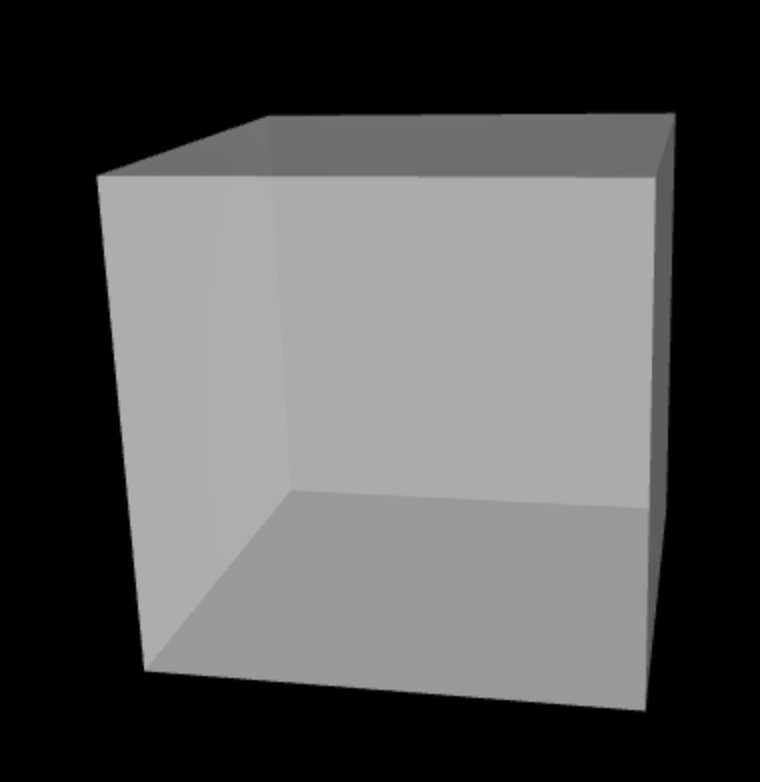CS460 Computer Graphics - University of Massachusetts Boston
Assignment 2
A




Remember to give credit!
My quick'n'dirty solution: https://cs460.org/shortcuts/01/

We want to send you mail!
CS460 Computer Graphics - University of Massachusetts Boston
Assignment 3



var geometry = new THREE.Geometry();
geometry.vertices.push(
new THREE.Vector3(-10, 10, 0),
new THREE.Vector3(-10, -10, 0),
new THREE.Vector3(10, -10, 0)
);
geometry.faces.push( new THREE.Face3(0, 1, 2));


GPU

Vertex Shader
Fragment Shader

Viewport
From 3D..
..to 2D
The Rendering Pipeline
Rasterization
Vertices
Face
From 3D to 2D
From 2D to 3D?
Unprojecting...




0, 0
width, height

renderer.domElement.onclick = function(e) {
pixel_coords = new THREE.Vector2(e.clientX, e.clientY);
};400, 200
400 , 200
Screen Space Coordinates

-1, -1

renderer.domElement.onclick = function(e) {
pixel_coords = new THREE.Vector2( e.clientX, e.clientY );
vp_coords = new THREE.Vector2(
( pixel_coords.x / window.innerWidth ) * 2 - 1, // X
- ( pixel_coords.y / window.innerHeight ) * 2 + 1 ); // Y
};-0.2, 0.3
-0.2
Viewport Coordinates
1, 1
0, 0
0.3


zNear
zFar

Ray
2D Click can be mapped to any
point on the 3D Ray


zNear
zFar

Ray
2D Click can be mapped to any
point on the 3D Ray
But we know the exact
position on zNear!
renderer.domElement.onclick = function(e) {
pixel_coords = new THREE.Vector2( e.clientX, e.clientY );
vp_coords = new THREE.Vector2(
( pixel_coords.x / window.innerWidth ) * 2 - 1, // X
- ( pixel_coords.y / window.innerHeight ) * 2 + 1 ); // Y
vp_coords_3d_near = new THREE.Vector3(vp_coords.x,
vp_coords.y,
0); // for zNear
};Towards 3D Coordinates
This is not 3D yet!
THREE.Raycaster


zNear
zFar

Ray
Position (x,y,z)

needs 2 points to define Ray
raycaster = new THREE.Raycaster();
raycaster.setFromCamera(vp_coords_near, camera);
zNear

Ray
Position (x,y,z)

Invisible Plane
intersects = raycaster.intersectObject( );
zNear

Ray
Position (x,y,z)

Invisible Plane
intersects = raycaster.intersectObject( );geometry = new THREE.PlaneBufferGeometry( 10000, 10000 );
material = new THREE.MeshBasicMaterial( {
visible: false
});
invisible_plane = new THREE.Mesh( geometry, material );
scene.add( invisible_plane );intersects = raycaster.intersectObject( invisible_plane );( 0, 0, 0 )
<html>
<head>
<meta charset="UTF-8" />
<style>
html, body {
background-color:#000;
margin: 0;
padding: 0;
height: 100%;
overflow: hidden !important;
}
</style>
<script src="https://threejs.org/build/three.min.js" type="text/javascript"></script>
<script src="https://threejs.org/examples/js/controls/TrackballControls.js" type="text/javascript"></script>
<script>
window.onload = function() {
// Three.js code goes here
scene = new THREE.Scene();
fov = 75;
ratio = window.innerWidth / window.innerHeight;
zNear = 1;
zFar = 10000;
// console.log(ratio);
camera = new THREE.PerspectiveCamera(fov, ratio, zNear, zFar);
camera.position.set( 0, 0, 100);
renderer = new THREE.WebGLRenderer();
renderer.setSize( window.innerWidth, window.innerHeight );
document.body.appendChild(renderer.domElement );
renderer.domElement.onclick = function( e ){
console.log('Yay! We clicked!');
pixel_coords = new THREE.Vector2( e.clientX, e.clientY );
console.log('Pixel coords', pixel_coords);
vp_coords = new THREE.Vector2(
( pixel_coords.x / window.innerWidth ) * 2 - 1, //X
-( pixel_coords.y / window.innerHeight ) * 2 + 1) // Y
console.log('Viewport coords', vp_coords);
vp_coords_near = new THREE.Vector3( vp_coords.x, vp_coords.y, 0);
};
ambientLight = new THREE.AmbientLight( 0x404040 );
scene.add( ambientLight );
light = new THREE.DirectionalLight( 0xffffff, 5.0);
light.position.set( 10, 100, 10 );
scene.add(light);
// now we add the cube
geometry = new THREE.BoxBufferGeometry( 20, 20, 20);
material = new THREE.MeshStandardMaterial({ color: 0xffffff });
cube = new THREE.Mesh( geometry, material);
scene.add(cube);
controls = new THREE.TrackballControls( camera, renderer.domElement );
animate();
};
function animate() {
requestAnimationFrame( animate );
// console.log('check');
controls.update();
// and here...
renderer.render( scene, camera);
};
</script>
</head>
<body></body>
</html><html>
<head>
<meta charset="UTF-8" />
<style>
html, body {
background-color:#000;
margin: 0;
padding: 0;
height: 100%;
overflow: hidden !important;
}
</style>
<script src="https://threejs.org/build/three.min.js" type="text/javascript"></script>
<script src="https://threejs.org/examples/js/controls/TrackballControls.js" type="text/javascript"></script>
<script>
window.onload = function() {
scene = new THREE.Scene();
fov = 75;
ratio = window.innerWidth / window.innerHeight;
zNear = 1;
zFar = 10000;
// console.log(ratio);
camera = new THREE.PerspectiveCamera(fov, ratio, zNear, zFar);
camera.position.set( 0, 0, 100);
renderer = new THREE.WebGLRenderer();
renderer.setSize( window.innerWidth, window.innerHeight );
document.body.appendChild( renderer.domElement );
ambientLight = new THREE.AmbientLight( 0x404040 );
scene.add( ambientLight );
light = new THREE.DirectionalLight( 0xffffff, 5.0 );
light.position.set( 10, 100, 10 );
scene.add( light );
// now we add the cube
// geometry = new THREE.BoxBufferGeometry( 20, 20, 20);
// material = new THREE.MeshStandardMaterial({ color: 0xffffff });
// cube = new THREE.Mesh( geometry, material);
// scene.add(cube);
//
// The invisible plane
//
geometry = new THREE.PlaneBufferGeometry( 10000, 10000 );
material = new THREE.MeshBasicMaterial( {
visible: false
});
invisible_plane = new THREE.Mesh( geometry, material );
scene.add( invisible_plane );
//
//
//
controls = new THREE.TrackballControls( camera, renderer.domElement );
animate();
//
// ACTION!
//
renderer.domElement.onclick = function(e) {
if (!e.shiftKey) {
e.preventDefault();
return false;
}
console.log('yes! you clicked!');
pixel_coords = new THREE.Vector2( e.clientX, e.clientY );
console.log('Pixel coordinates', pixel_coords);
vp_coords = new THREE.Vector2( ( pixel_coords.x / window.innerWidth ) * 2 - 1,
-( pixel_coords.y / window.innerHeight ) * 2 + 1);
console.log('Viewport coordinates', vp_coords);
vp_coords_near = new THREE.Vector3( vp_coords.x, vp_coords.y, 0);
raycaster = new THREE.Raycaster();
raycaster.setFromCamera(vp_coords_near, camera);
intersects = raycaster.intersectObject(invisible_plane);
console.log('Ray to Invisible Plane', intersects[0].point);
// update cube position
// cube.position.set(intersects[0].point.x, intersects[0].point.y, intersects[0].point.z);
};
};
function animate() {
requestAnimationFrame( animate );
controls.update();
renderer.render( scene, camera );
};
</script>
</head>
<body></body>
</html>This is also Assignment 03 starter code!
Shaders
GLSL
A rather complex example of shaders:
Vertex Shader
Fragment Shader


Vertex Shader

attribute vec4 a_position;
void main() {
gl_Position = a_position;
}This shader does nothing besides passing through positions.
Vertex Shader

attribute vec4 a_position;
void main() {
gl_Position = a_position;
}This shader does nothing besides passing through positions.
data is different for each vertex!
(x, y, z, w)
(x, y, z, 1.)
name
Vertex Shader

attribute vec4 a_position;
void main() {
gl_Position = a_position;
}This shader does nothing besides passing through positions.
gl_Position is the output of any vertex shader
Fragment Shader
precision mediump float;
void main() {
gl_FragColor = vec4(1., 1., 1., 1.);
}This shader colors every fragment (pixel) white.

Fragment Shader
precision mediump float;
void main() {
gl_FragColor = vec4(1., 1., 1., 1.);
}This shader colors every fragment (pixel) white.

defines the number of decimals for every value
Fragment Shader
precision mediump float;
void main() {
gl_FragColor = vec4(1., 1., 1., 1.);
}This shader colors every fragment (pixel) white.

every fragment shader outputs a color for
the current fragment / pixel.
Fragment Shader

Vertex Shader

gl_Position
gl_FragColor
for every vertex
for every pixel
Fragment Shader

Shader Art
